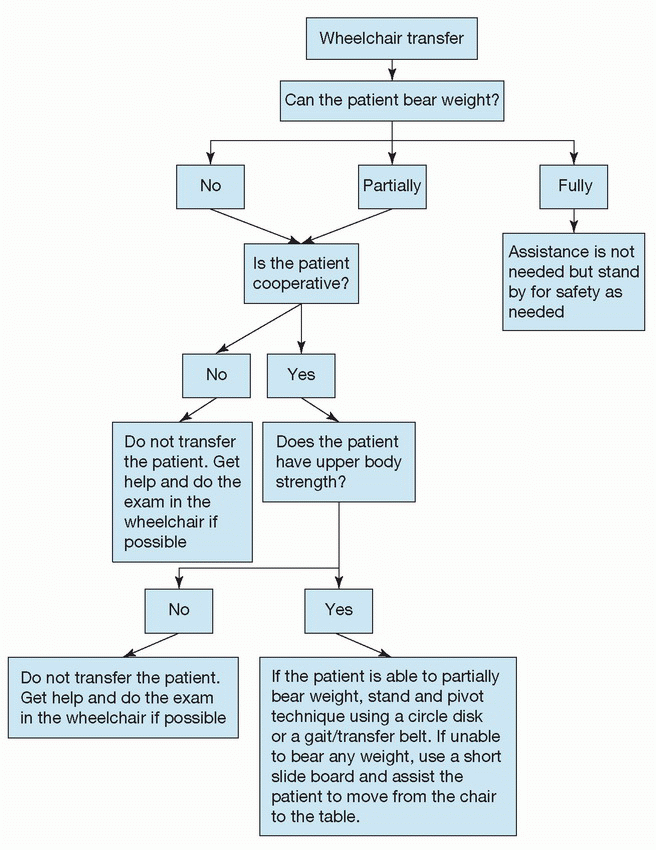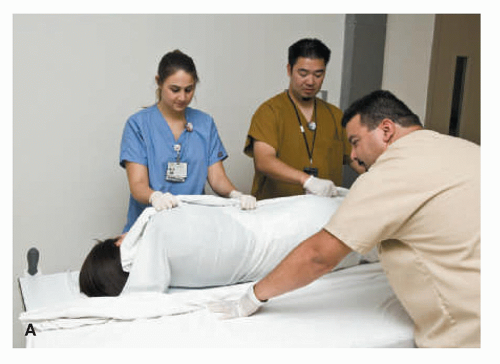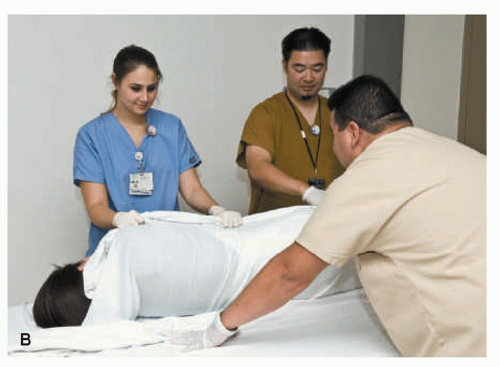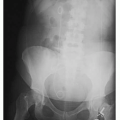Patient Care and Safety
OBJECTIVES
After studying this chapter, the student will be able to:
1. Explain the best methods for ensuring the care and safety of the patient’s belongings while in the radiography department.
2. Describe how proper body mechanics will help prevent injury to the technologist.
3. List the safety measures that must be taken when transferring a patient from a hospital room to the radiographic imaging department via wheelchair or gurney.
4. Describe steps that must be taken by the radiographer to protect the patient’s integumentary system from injury.
5. Explain the criteria to be used when immobilization of a patient is necessary.
6. List the types of immobilizers available and demonstrate the correct method of applying each one.
7. Demonstrate the correct method of moving and positioning a patient to prevent injury to the patient or the radiographer.
8. Assess correctly a patient’s need for assistance to complete a radiographic procedure safely.
9. Discuss the legal ramifications for failing to safely move a patient from a gurney or a wheelchair to an x-ray table.
10. Give clear verbal instructions to an ambulatory patient concerning the correct manner of dressing and undressing for a radiographic procedure.
11. Demonstrate the correct method of assisting a disabled patient with dressing or undressing for a radiographic procedure.
12. List the precautions to be taken if a patient is in traction or wearing a cast.
13. Explain the responsibilities of a radiographer concerning radiation safety.
14. List the departmental safety measures that must be taken to prevent and control fires, patient falls, poisoning or injury from hazardous materials, and burns, as well as the measures to evacuate patients in case of a disaster.
KEY TERMS
Ambulatory: Walking or able to walk
Atrophy: Decrease in the size of the organ, tissue, or muscle
Decubitus ulcer: A pressure sore
Dyspnea: Labored or difficult breathing
Footdrop: The inability to dorsiflex the foot as a result of weakness of the dorsiflexor muscles
Immobilizer: Any device that is used to limit or prevent movement of a patient that might cause injury to self or others
Ischemia: Deficiency of blood in a body part due to functional constriction or actual obstruction of a blood vessel
Tissue necrosis: Localized death of tissue due to injury or lack of oxygen
Ulceration: An area of tissue necrosis that penetrates below the epidermis; excavation of the surface of any body organ
Approaching the patients in a courteous and tactful manner can put them at ease and decrease their level of embarrassment so that the procedure can be performed in a smooth and timely manner. The radiographer sets the tone for the entire exchange when a patient arrives as an outpatient. Ensuring the patient that any belongings will be kept in a safe place or allowing the patients to take their belongings with them will give a sense of security. All departments have different patient dressing room arrangements, but it is the responsibility of the attending radiographer to ensure that the patients’ belongings are secure.
Radiographers are responsible for protecting themselves and the patient from injury in every way possible. Health care workers are often injured while moving and lifting patients, but almost all these injuries are preventable if the correct body mechanics and rules of safety are used. Patients are also victims of injuries caused by being improperly moved or lifted. Most of these injuries can also be prevented. It is imperative that each situation be assessed and enough help is obtained to prevent injury.
Moving a patient from the radiographic table to a gurney or wheelchair, or from a hospital bed to a gurney or wheelchair, requires some forethought regarding the safety of the patient as well as to the body mechanics used. Special care with the ancillary equipment must be taken when moving it with a patient during transport. A patient’s integumentary system must be protected from damage. This is of particular concern when the patient is unable to assist in a move.
Occasionally, a patient may have to be immobilized for safety reasons during a radiographic procedure. Not only must the institution-specific rules concerning immobilizers be learned, but the correct use of these devices must also be carefully learned to protect the patient from harm.
Adhering to rules of radiation safety, preventing and controlling fires, using and disposing of hazardous chemicals correctly, and observing other rules of patient and departmental safety are important parts of the radiographer’s education.
CARE OF PATIENT’S BELONGINGS
A patient who comes to the radiology department as an outpatient is frequently required to remove all or some items of clothing and to put on a patient gown before a procedure or treatment can be performed. It is usually the radiographer who receives the patient and determines which items of clothing are to be removed. The patient’s discomfort or embarrassment can be decreased if the situation is approached in a courteous and professional manner.
After the patient is taken to the specific dressing area, clearly explain how to put on the examining gown and point out where to go for the examination once prepared. Remember that not everyone knows that some types of examining gowns open at the back rather than at the front; this information should be part of the explanation. Doing this takes only a few moments, and it will make the patient feels more comfortable.
If it is permissible to leave clothing in the dressing room, explain this to the patient. Dressing room doors or cubicles should have hooks provided for the patient to hang up clothes. If the patient cannot leave the clothing in the dressing cubicle, make this part of the explanation. Many departments provide plastic bags with handles that are large enough to hold all clothes, shoes, and even purses. These bags allow patients to take their items with them. It is important that purses, jewelry, and other valuables should be treated with special care so that they will not be lost or stolen.
Many female patients wear jewelry and/or carry a purse to the radiology department. The dressing rooms in most departments are not safe places to leave these items, and the patient may feel justifiably uneasy about leaving them there. Again, consider the patient’s concern and explain what must be done with personal items to keep them safe.
Metal items, such as necklaces, rings, and watches, are not to be worn for particular diagnostic procedures and must be removed before beginning the procedure. An envelope or other container large enough to accommodate all such items should be offered to the patient. In the event that the items must be removed from the room, identifying information should be written on a receipt, and all items should be tagged and placed in the designated safety area. This procedure will prevent losses that may result in inconvenience and expense to both the patient and the department. If the patient is allowed to wear the items into the radiography room for a short procedure (such as chest images), the patient should be allowed to
hold the jewelry if possible. If this is not possible, place the jewelry in a cup, basin, or envelope and place the container in an area where the patient can see it.
hold the jewelry if possible. If this is not possible, place the jewelry in a cup, basin, or envelope and place the container in an area where the patient can see it.
Patients may have body piercings that are not visible. It is important to ask the patient if there is any jewelry or body piercings. If so, ask the patient to remove the jewelry (if possible) so that it will not be visible on the radiographic image. If the patient refuses to do so, which may be likely for body piercings, especially if they are new, this must be noted on the request so that the radiologist can make this known in the report to the referring clinician.
Do not place a personal value on a patient’s belongings. An item that may seem insignificant to others may be the patient’s most treasured belonging. Every article of clothing or jewelry and the personal effects that a patient brings to the diagnostic imaging department should be treated with care.
BODY MECHANICS
Constant abuse of the spine from moving and lifting patients is the leading cause of injury to health care personnel in all health care institutions. Thirty-seven percent of all workmen’s compensation cases are due to injury from patient handling. Following the correct rules of body mechanics will reduce the amount of fatigue and chance of injury. Rules of body mechanics are based on the laws of gravity.
Gravity is the force that pulls objects toward the center of the earth. Any movement requires an expenditure of energy to overcome the force of gravity. When an object is balanced, it is firm and stable. If it is off balance, it will fall because of the pull of gravity. The center of gravity is the point at which the mass of any body is centered. When a person is standing, the center of gravity is at the center of the pelvis.
Safe body mechanics require good posture. Good posture means that the body is in alignment with all the parts in balance. This permits the musculoskeletal system (bones and joints) to work at maximal efficiency with minimal amount of strain on joints, tendons, ligaments, and muscles. Good posture also aids other body systems to work efficiently. For instance, if the chest is held up and out, then the lungs can work at maximal efficiency.
Correct upright posture is accomplished by
holding the chest up and slightly forward with the waist extended. This allows the lungs to expand properly and fill to capacity;
holding the head erect with the chin held in. This puts the spine in proper alignment, with a normal curve in the neck;
standing with the feet parallel and at right angles to the lower legs. The feet should be 4 to 8 inches apart. Keep body weight equally distributed on both feet;
keeping the knees slightly bent. They act as shock absorbers for the body;
keeping the buttocks in and the abdomen up and in. This prevents strain on the back and abdominal muscles.
The forces of weight and friction must be overcome when moving and lifting objects. Keep the heaviest part of the object close to the body. If this is not possible, additional help should be obtained to assist with moving or lifting the load.
The force of friction opposes movement. When moving or transferring a patient, reduce friction to the minimum to facilitate movement. This can be done by reducing the surface area to be moved or, in the case of a patient, using some of the patient’s own strength to assist with the move, if possible. If the patient is unable to assist, reduce friction by placing the patient’s arms across the chest to reduce the surface area. The surface over which the patient must be moved must be dry and smooth. Pulling rather than pushing also reduces friction when moving a heavy object or person. A sliding board or pull sheet placed under an immobile patient also reduces friction. Directions for the use of these items are presented later in this chapter.
To avoid self-injury when moving heavy objects, remember to keep the body’s line of balance closest to the center of the load. Keep the following rules in mind when lifting or moving heavy objects:
When picking up an object from a low table or the floor, bend the knees and lower the body. Do not bend from the waist (Fig. 4-1).
The biceps are the strongest arm muscles and are effective when pulling; therefore, pull heavy items or patients rather than push them.
Always protect the spine. Rather than twisting the body to move a load, change the foot position instead. Always keep the body balanced over the feet, which should be spread to provide a firm base of support.
When assisting a patient to move, balance the weight over both feet and keep one foot slightly ahead of the other. Stand close to the patient, flex the gluteal muscles, and bend the knees to support the load. Use arm and leg muscles to assist in the move.
Make certain that the floor area is clear of all objects.
To prevent lower back injury, always keep the center of gravity, with the knees flexed and the weight over both feet. Do not bend at the waist or twist with the body.
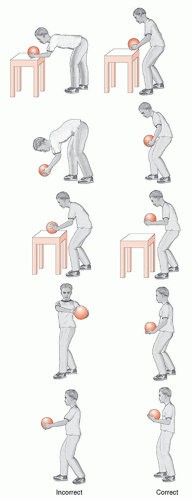 FIGURE 4-1 Keep the body balanced over the feet to provide a broad base of support. Squat, don’t bend at the waist; pull, don’t push; don’t twist at the waist; and keep the object close to you. |
Proper body mechanics alone do not prevent injury; it only decreases the chance of injury. It must be remembered that body mechanics only focuses on the lower back when doing lateral transfers and not on the other parts of the body such as the shoulders and lower neck muscles that are injured from boosting and repositioning a patient. As our body ages, the chance of injury to the back increases. More care must be taken by obtaining more assistance to prevent injury to both the worker and the patient.
MOVING AND TRANSFERRING PATIENTS
The radiographer may be called upon to transfer or assist in transferring a patient from a hospital room to the diagnostic imaging department. Several precautions must be taken when moving a patient from the hospital room to the imaging department.
1. Establish the correct identity of the patient. Identify yourself and the reason for being there. Ask to see the identification wristband. This is extremely important because many times the patient has been transferred to another room since the radiology request was submitted.
2. Request pertinent information concerning the patient’s ability to comply with the physical demands of the procedure while at the nurses’ station.
3. Request information concerning the patient’s ability to
ambulate and any restriction or precautions to be taken concerning the patient’s mobility while at the nurses’ station.
4. Move the patient to the imaging department according to the necessary restrictions.
Never move a patient without first ensuring the patient’s identity matches the requested order!
Never move a patient without enough assistance to prevent injury to you and/or the patient.
Never move a patient without assessing the patient’s ability
When the imaging procedure is completed, return the patient to the hospital room using the following procedures:
1. Stop at the appropriate nurses’ station and inform the unit personnel that the patient is being returned to the room. Request help if it is needed at this time.
2. Return the patient to the room, help the patient get into bed, and assure comfort and safety. Place the patient’s bed in the position that is closest to the floor with the side rails raised and the call button within reach in case the patient needs assistance.
If the patient is from the outpatient waiting area, walk the patient back to the waiting room and thank them. Your communication with your patient at the end of the study is just as important as performing the study itself. Walking the patient to the waiting area where the interaction began is courteous and should be part of the completion of the examination.
To prevent possible patient injury, always lower the bed to the lowest position and secure the rails in the upright position when a patient is returned to bed.
Assessing the Patient’s Mobility
Before beginning to move a patient, critical thinking and problem-solving skills must be used to plan the most effective manner of accomplishing the task. The expected outcome of this plan will be to accomplish the move without causing additional pain or injury to the patient. Use interviewing and assessment skills to complete this. Ask the patient about any ability to help with the transfer. However, the technologist cannot assume that the patient is really capable of performing the move as indicated. Many patients may think they can do something and are not aware that they are weaker than they think.
Whether getting an outpatient from the waiting room or transferring a patient from the floor, look for the following during patient assessment:
1. Deviations from correct body alignment. Deviations in normal physiologic body alignment of the patient may result from poor posture, trauma, muscle damage, dysfunction of the nervous system, malnutrition, fatigue, or emotional disturbance. Support blocks or pillows, which are used to assist the patient during the procedure, must be available.
2. Immobility or limitations in range of joint motion. Any stiffness, instability, swelling, inflammation, pain, limitation of movement, or atrophy of muscle mass surrounding each joint must be noted and considered in the plan of transfer and care.
3. The ability to walk. Gait includes rhythm, speed, cadence, and any characteristic of walking that may result in a problem with balance, posture, or independence of movement. Before beginning the move, the amount of assistance needed to safely complete the move and procedure must be planned.
4. Respiratory, cardiovascular, metabolic, and musculoskeletal problems. Obvious respiratory or cardiovascular symptoms that impair circulation and signal potential problems in positioning must be planned for. Metabolic problems, such as diabetes mellitus or rheumatoid arthritis, may be discovered during the interview process and planned for as necessary. (Symptoms and care of patients with medical problems are discussed in Chapter 9.)
Other assessment considerations are the following:
1. The patient’s general condition, such as range of motion and weight-bearing ability, strength and endurance, and balance.
2. The patient’s ability to understand what is expected during the transfer. Is the patient responsive and alert? Has the patient received a sedative, hypnotic, or other psychoactive drug in the past 2 or 3 hours? Will any medication that has been taken affect the ability to move safely?
3. The patient’s acceptance of the move. Does the patient fear or resent the transfer? Will the transfer increase the pain? Does the patient feel that the move is unnecessary, or perhaps the procedure itself?
Before going to the patient, a consultation with the staff in charge of the patient is recommended so that the patient’s condition and limitations can be understood. If assistants are needed, they must be on hand or readily available for the radiographer. A patient must never be moved without adequate assistance because doing so
may cause injury to the patient or the radiographer. The radiographer must decide how the patient can be transferred safely and comfortably, whether by gurney or by wheelchair. In some cases, the radiology request will state that the patient can travel by wheelchair, but upon an accurate assessment and consultation, the radiographer discovers that the patient is unable to sit in a wheelchair and must be transported by gurney. Hospital patients are seldom allowed to walk to and from the diagnostic imaging department for reasons of safety. Someone must always be at the patient’s side during a transfer. The following rules should be observed during a move:
may cause injury to the patient or the radiographer. The radiographer must decide how the patient can be transferred safely and comfortably, whether by gurney or by wheelchair. In some cases, the radiology request will state that the patient can travel by wheelchair, but upon an accurate assessment and consultation, the radiographer discovers that the patient is unable to sit in a wheelchair and must be transported by gurney. Hospital patients are seldom allowed to walk to and from the diagnostic imaging department for reasons of safety. Someone must always be at the patient’s side during a transfer. The following rules should be observed during a move:
1. Give only the assistance that the patient needs for comfort and safety.
2. Always transfer a patient across the shortest distance.
3. Lock all wheels on beds, gurneys, and wheelchairs before the move begins.
CASE STUDY
The late afternoon shift was just beginning at a well-known medical center in one of the largest cities in the United States. A patient, who was 1 day postoperative brain surgery, was in the department for radiographic studies of her abdomen. The technologist explained the move from the gurney to the examining table to the patient. She assured the technologist that she was able to move. After locking the brakes on the gurney, the technologist went around the table to pull the patient onto the table. However, the patient was unable to move her lower body from the gurney. Every time she pushed with her heels, the gurney moved slightly away from the table. The technologist held onto the patient’s arm, but was unable to keep her from falling between the gurney and the table causing her to strike her head against the corner as she fell.
Through the legal discoveries in this court case, it was determined that there were other technologists readily available outside the room. There was also a smooth transfer board hanging on the wall in the radiographic room.
DISCUSSION QUESTIONS:
1. Because the patient was a recent postoperative brain surgery patient, what kind of assessment should have been done prior to beginning the move?
2. What other issues should the technologist have addressed before he started the move?
3. Once it became apparent that the patient was unable to accomplish the move as directed, what should have occurred?
4. Discuss why the gurney was sliding away from the x-ray table despite the brakes having been set.
5. Do you believe that the patient “was at fault” for informing the technologist that she could, in fact, move on her own? Why or why not?
Sadly, the case study above is a true story. While the student might think that no one would do something like this, it only takes a moment of poor judgment to assume that nothing will happen and lives are changed forever. The technologist’s strongest ally is critical thinking in terms of action and consequences. Every action has a consequence. The most important one is the one that has a good outcome.
4. Generally, it is better to move a patient toward the stronger side while assisting on the patient’s weaker side.
5. The patient should wear shoes or hospital socks for standing transfers, not personal socks, which may be slippery. Hospitals do provide transfer socks that have gripping soles to prevent the patient from slipping on the tile floors of the hospital.
6. Inform the patient of the plan for moving and encourage any help.
7. Give the patient short, simple commands and help the patient to accomplish the move.
Legalities of an Incorrect Transfer
As stated earlier, assistants must be available for help when moving a patient from a gurney or wheelchair to the x-ray table and back. The radiographer must never assume that the patient fully understands the ability to
move from one area to another. It is the radiographer who is responsible for making the decision to request help. To not obtain the help or resources available may end in severe consequences for both the patient and the radiographer.
move from one area to another. It is the radiographer who is responsible for making the decision to request help. To not obtain the help or resources available may end in severe consequences for both the patient and the radiographer.
Methods of Moving Patients
There are essentially three ways of transferring patients: by gurney, by wheelchair, and by ambulation. Walking a patient from a room within the hospital to the imaging department is not advisable for safety reasons. Patients that are in the outpatient waiting area should also be assessed before deciding on the ability to walk into the examining room. Be sure to determine what is allowable and appropriate in the facility.
By Gurney
When a patient is moved from a gurney to a radiographic table, or the reverse, great care must be taken to prevent injury. If the patient is unconscious or unable to cooperate in the move, the patient’s spine, head, and extremities must be well supported. Convenient and safe ways to do this are using a sheet or a sliding board to move the patient from one surface to another. Refer to the procedure sections and video clips for information on how to use a sheet or sliding board to transfer a patient.
|
By Wheelchair
Although it may seem that a patient in a wheelchair is more capable of assisting with a transfer, such is not always the case. Always be by the patient’s side to assist in any manner that is needed. The patient being moved from a room on the floor may not have been out of bed for a period of time and may be light-headed and less strong as was anticipated. This, combined with the motion of the wheelchair as it moves quickly down the hall to the radiology department, may be enough to cause the patient to become dizzy and fall. Using proper body mechanics will help prevent an injury to the technologist as well as to the patient in situations that may arise due to unsteadiness. Use the following flowchart to assess the patient’s need for assistance. Once the assessment has been made, refer to the procedure section and watch the video clip to assure complete knowledge of the transfer.
PROCEDURE
Sheet Transfer
To place a sheet under a patient:
1. Obtain a heavy draw sheet or a full bedsheet that is folded in half. Have one person stand on each side of the table or bed at the patient’s side.
2. Turn the patient onto the side that is opposite to the side or direction that the patient is being moved to.
3. Place the sheet on the table or bed with the fold against the patient’s back (Fig. 4-2A).
4. Roll the top half of the sheet as close to the patient’s back as possible (Fig. 4-2B). Inform the patient to roll onto the back and over the rolled sheet.
5. Finally, turn the patient to the other side and off the roll of the sheet. The assistant should straighten the sheet, making it flat for the patient to be laid on (Fig. 4-2C). Return the patient to a supine position, and the transfer may begin.
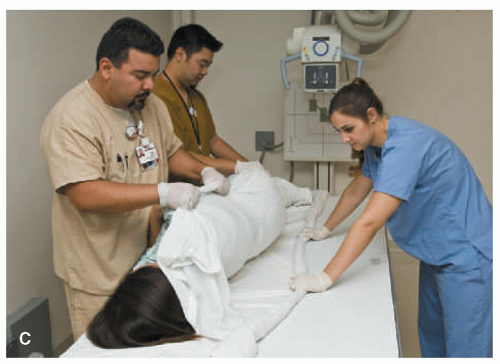 FIGURE 4-2 (C) After the patient is rolled to the opposite side, the rolled half of the sheet is straightened out. |
To transfer the patient after placing the sheet:
6. If the patient is an adult, three or four people should participate in the maneuver. One person stands at the patient’s head to guide and support it during the move, with another at the side to which the patient will be moved, and a third person at the side where the patient is lying. If there are four people, two may stand at each side.
7. The sheet is rolled at the side of the patient so that it can easily be grasped, close to the patient’s body. In unison (usually on the count of three), the team transfers the patient to the other surface. Extra care over the radiographic table’s metal edges should be taken as well as ensuring that the x-ray tube housing is positioned out of the way.
PROCEDURE
Log Roll
In the event, a trauma patient must be moved and there is no sheet or other means to transfer the patient, a procedure known as a log roll must be used. The objective of the log roll procedure is to maintain correct anatomic alignment in order to prevent the possibility of further, catastrophic neurologic injury and the prevention of pressure sores.
At least three people are required to assist in the log roll procedure:
1. One person must hold the patient’s head.
2. Two people must support the chest, abdomen, and lower limbs on either side of the patient. If the patient is obese, tall, or has lower limb injuries, a third person on the patient’s side may be necessary.
3. Explain the procedure and ask the patient to lie still and to not move.
4. Make sure that urinary catheters, intravenous (IV) tubing, and so on are repositioned to prevent overextension and dislodgement during movement. Make sure that the patient is anatomically aligned before rolling.
5. The patient’s arm away from the side of intended turn must be extended along the thorax and abdomen or bent over the chest if appropriate.
6. Place a pillow between the patient’s legs.
7. One assistant on the side of the patient supports the patient’s upper body by placing one hand on the shoulders and the other hand around the patient’s thighs.
8. The other assistant supports the patient’s abdomen and lower limbs by overlapping with the first assistant’s arm to place one hand under the patient’s lower back and the other hand over the patient’s lower legs.
9. The technologist holding the patient’s head directs the turn. Upon direction, the patient is turned in anatomic alignment in one smooth action.
10. Once a sheet or smooth mover is placed under the patient to assist in the move, the patient is returned to the supine position to be moved as stated earlier.
The patient who is suspected of spinal injury must be kept in correct anatomic alignment at all times.
PROCEDURE
Lateral Transfer
The lateral transfer is best accomplished with the use of a sliding board (also called a smooth mover or a “smoothie”). There are two lengths of this glossy, plasticized board that will be used in different situations. The long board is approximately 5 ft 10 inches in length and about 2 ft 6 inches wide. This length is used for transfer for a supine patient moving from one flat surface to another. There is also a short board that is approximately 3 ft long and 2.5 ft wide and is used for transfer from a sitting position to another surface. The sliding board usually requires fewer personnel to make the move than the sheet transfer because it creates a firm bridge between the two surfaces over which the patient can be easily moved. The sliding board transfer procedure is as follows:
1. After assessing whether the patient is able to assist in the move, and the patient’s approximate weight, a determination of the amount of assistants necessary can be made. Use
the long board and two to four assistants if the patient is over 150 lb. If the patient is more than 250 lb, a minimum of four assistants will be necessary. A Hover-Matt may be necessary if the patient is over 350 lb.
the long board and two to four assistants if the patient is over 150 lb. If the patient is more than 250 lb, a minimum of four assistants will be necessary. A Hover-Matt may be necessary if the patient is over 350 lb.
2. Obtain the sliding board and spray it with antistatic spray if necessary. Moving a patient on this board may create static electricity and cause the technologist to be shocked when touching the metal edges of the table or gurney.
3. Obtain the assistance of personnel as determined in step 1.
4. Move the patient to the edge of the gurney. One person should hold the sheet that the patient is lying on over the top of the patient to keep the patient from possibly rolling off the gurney.
Stay updated, free articles. Join our Telegram channel

Full access? Get Clinical Tree



